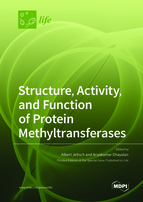Structure, Activity, and Function of Protein Methyltransferases
A special issue of Life (ISSN 2075-1729). This special issue belongs to the section "Proteins and Proteomics".
Deadline for manuscript submissions: closed (30 November 2021) | Viewed by 68605
Special Issue Editors
Interests: DNA methyltransferases; DNA methylation; protein methyltransferases; protein methylation; reading domains; molecular epigenetics; synthetic biology; molecular enzymology
Special Issues, Collections and Topics in MDPI journals
Interests: protein arginine methyltransferases; histone arginine methylation; reader proteins; DEAD box family of RNA helicases
Special Issues, Collections and Topics in MDPI journals
Special Issue Information
Dear Colleagues,
This Life Special Issue entitled "Structure, Activity, and Function of Protein Methyltransferases” will collect reviews about individual Protein methyltransferases supplemented by some topical reviews all written by leading experts in the field. The scope covers Protein lysine methyltransferases, Protein arginine methyltransferases, but also the less abundant Protein glutamine methyltransferases, Protein histidine methyltransferases and Protein N-terminal end methyltransferases. This concept will make the special issue a very useful resource for researchers from the entire Protein methylation and Protein methyltransferase field.
The scope of the special issue includes histone methyltransferases involved chromatin regulation but also methylation of non-histone proteins. Topics to be considered in the individual enzyme reviews include structural features (domain architecture, homologs and paralogs, structure), biochemical features (mechanism, sequence specificity, product specificity, regulation, substrates), cellular features (subcellular localization, expression patterns, cellular roles and function, biological effects of substrate protein methylation, connection to cell signaling pathways, connection to chromatin regulation) as well as connection to diseases. Reviews should be closed with an outlook, open questions, and directions for future research.
We invite suggestions for manuscripts to be included in this special issue. Please contact the editors before preparing the manuscript for a pre-arrangement of the topic.
Prof. Dr. Albert Jeltsch
Dr. Arunkumar Dhayalan
Guest Editors
Manuscript Submission Information
Manuscripts should be submitted online at www.mdpi.com by registering and logging in to this website. Once you are registered, click here to go to the submission form. Manuscripts can be submitted until the deadline. All submissions that pass pre-check are peer-reviewed. Accepted papers will be published continuously in the journal (as soon as accepted) and will be listed together on the special issue website. Research articles, review articles as well as short communications are invited. For planned papers, a title and short abstract (about 100 words) can be sent to the Editorial Office for announcement on this website.
Submitted manuscripts should not have been published previously, nor be under consideration for publication elsewhere (except conference proceedings papers). All manuscripts are thoroughly refereed through a single-blind peer-review process. A guide for authors and other relevant information for submission of manuscripts is available on the Instructions for Authors page. Life is an international peer-reviewed open access monthly journal published by MDPI.
Please visit the Instructions for Authors page before submitting a manuscript. The Article Processing Charge (APC) for publication in this open access journal is 2600 CHF (Swiss Francs). Submitted papers should be well formatted and use good English. Authors may use MDPI's English editing service prior to publication or during author revisions.
Keywords
- protein methyltransferase
- protein lysine methyltransferase
- protein arginine methyltransferase
- protein glutamine methyltransferase
- protein histidine methyltransferase
- protein methylation
- histone methylation
- chromatin regulation
- non-histone protein methylation








